
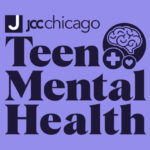
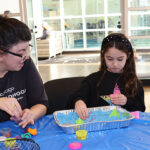
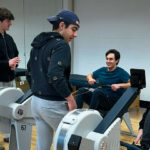
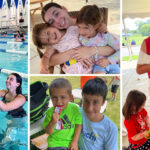
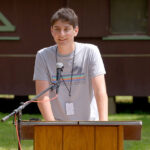
More than 100 years ago, we were founded as a gathering place for new immigrants to fill their lives with culture, language, recreation, and always, always connection.
But 100 years of continuous service in Chicago is what we call a good start.
Our legacy gives us permission to transcend our past and empowers us to transform our future with innovative thinking, dynamic programs and game-changing opportunities that will bridge traditions and generations.
We will continue to embrace our Jewish values and reimagine them for a more connected, inspired community.
1903 – 1913
Many Jewish immigrants flocked to the new Chicago Hebrew Institute seeking acculturation opportunities and a social gathering place, programs and services also expanded to accommodate the needs of this population.
In 1907, Chicago Hebrew Institute’s President, Nathan Kaplan asked philanthropist Julius Rosenwald for his support in purchasing a larger facility for Chicago Hebrew Institute. Rosenwald made a generous contribution, and in 1908 the Institute moved to a larger property at Taylor and Lytle Streets in Chicago. The new 20-acre facility at Taylor and Lytle Streets offered the Jewish community a wider array than ever of year-round educational, cultural and social programs for all ages.
In 1911, a group of women banded together to form the Women’s Auxiliary to assist in the establishment in a more permanent Chicago Hebrew Institute. The Women’s Auxiliary played a vital role in supporting and financing experimental projects and providing services which the existing budget did not offer.
A fire destroyed the entire main building of the Chicago Hebrew Institute in 1910, which was rebuilt in 2012. By 1913, over 280,000 men, women and children participated in the Institute’s offerings.
In 1913, the Chicago Hebrew Institute appointed Philip Seman as General Director, a position he held with national distinction for the next 32 years. Under Seman’s leadership, the Institute grew significantly and its many achievements placed it securely in the front ranks of social service agencies.
1914 – 1924
When Philip Seman came into his role as General Director of Chicago Hebrew Institute, eastern European Jews faced very poor housing and sanitary conditions. They lived in cramped quarters with rudimentary plumbing and minimal money to spend on food, clothing and recreation.
Prior to Chicago Hebrew Institute, Jewish immigrants attended Jane Addams Hull House—becoming the largest ethnic group to use its programs and services. With the establishment of Chicago Hebrew Institute, most of the Jewish population left Hull-House for the Institute, but Seman adopted many of Jane Addam’s philosophies and practices in molding Chicago Hebrew Institute. While Chicago Hebrew Institute was modeled after Hull-House in many ways, its focus on Jewish culture made it unique.
Seman’s plan for Chicago Hebrew Institute was not only to teach eastern European Jews English and marketable skills for employment, but to also emphasize activities that improved their minds and bodies.
Chicago Hebrew Institute understood that unemployment and poverty was a pervasive condition for many in the Jewish community. In response, the Institute opened a Milk Station in 1914 to provide basic nourishment and sustenance to impoverished new Americans. Families paid one penny per glass, and by the end of the first week, the Station had sold over 6,000 glasses.
To continue Phillip Seman’s and Chicago Hebrew Institute’s mission of providing opportunities for self-improvement and healthy physical development, the Institute opened its first state-of-the-art gymnasium and natatorium on Taylor and Lytle Streets in 1915. The gymnasium featured 2 gyms, 2 swimming pools and an indoor track and was made possible by a generous donation by philanthropist Julius Rosenwald.
1916
To continue its commitment to education, the Institute opened an evening high school for working men and women who wanted to further their education. The school was later accredited by the University of Illinois and the North Central Association of Colleges and Secondary Schools.
The founding mothers and fathers of JCC recognized that children needed the benefits of being away from the oppressive living conditions of crowded apartments and the hustle and bustle of the city. In the summer of 1921, Camp CHI opened as an all-girls camp at Loon Lake in Antioch, Illinois, serving a total of 559 young girls. The camp offered classes in hygiene, sewing, athletics, Jewish rituals, dance pageants and other various activities. JCC’s Women’s Auxiliary members spent the summer in Antioch as counselors.
1922
Chicago Hebrew Institute was renamed the Jewish People’s Institute (JPI).
1925 – 1935
JPI on Taylor and Lytle Streets continued to expand its programs and services, but Chicago’s Jewish community had begun to move to new areas, especially to the Lawndale District.
1927
JPI relocated its facilities to the Lawndale District (3500 Douglas Blvd., Chicago) to meet the needs of this Jewish community. The new JPI building was made possible by a fund drive chaired by President Jacob Loeb . The new JPI building was the largest and most modern facility of its kind in the country. The four-story building, designed specifically to be a community center, included a gymnasium, swimming pool, auditorium/ theatre and magnificent roof gardens that quickly become the focus of summer activity for the Lawndale Jewish community.
1931
The estimated Jewish population in the Lawndale area was 75,400 people, 67%. JPI’s membership soared for the following 2 ½ decades.
1932
JPI opened its first day camp in Chicago.
1933
During the Depression, the City of Chicago was forced to close Crane Junior College because of lack of funds. JPI created the People’s Junior College (housed at the JPI building) to help thousands of students continue their college educations. The college remained in operation at JPI until 1936 when the City of Chicago was able to re-open public sponsored junior colleges.
1935
JPI created and launched its first nursery school program
1939
JPI affiliated with Jewish Charities (later known as the Jewish Federation of Metropolitan Chicago)
During the late 1930’s, Chicago’s Jewish population began to shift to new neighborhoods throughout the city. To accommodate service needs in these new areas, JPI developed neighborhood branches and opened the Max Straus Center in 1941 (West Wilson Avenue, Albany Park).
1946
To reflect the new neighborhood branch concept, JPI changed its name to Jewish Community Center of Chicago (JCC).
Also in 1946, in response to a study that revealed a desperate need for group services for the elderly, JCC established the Golden Age program (later named the Senior Adult Program). Golden Age Clubs brought older community residents for social events, classes, city tours and travel opportunities. By 1953, JCC served over 800 older adults at 11 Golden Age Clubs throughout Chicagoland.
1949
JCC of Chicago established two new branches: Hyde Park Club (5200 S. University Ave, Chicago) and Rogers Park JCC (1222 W. Morse Ave., Chicago).
By 1951, the Jewish population around the JPI building in Lawndale had declined drastically to an estimated 42,300 people (from 75,400), as Jews began to move to new neighborhoods. In 1955 the JPI Building in the Lawndale area (3500 W. Douglas Blvd) was closed and sold to the Chicago Board of Education.
1952
Camp Chi relocated from Loon Lake, IL to Lake Delton, Wisconsin (its current site), and in 1955, Camp Chi transformed from an all-girls resident camp to a co-ed resident camp.
1955
The Rogers Park JCC relocated from 1222 West Morse Ave., Chicago to 7101 N. Greenview Ave., Chicago.
1957
A group of Rabbis from Niles Township visited the Jewish Federation to plead for the establishment of a JCC in their community. They believed that Jewish teens needed help adjusting to suburban life. This led to the establishment of the Niles Township JCC (4017 Church Street, Skokie).
1959
The agency opened the Henry N. Hart JCC (9101 S. Jeffery Blvd., Chicago).
1960
The Bernard Horwich JCC opened in Rogers Park (3003 W. Touhy Ave, Chicago).
Also in 1960, JCC created the Mayer Kaplan Senior Adult Center at the Bernard Horwich JCC. This was the first community center facility initiated specifically to serve older adults.
1966
A separate teen camp and senior adult camp were opened on the grounds of Camp Chi (Lake Delton, WI). The facility offered pre-and post-summer season camping for families. Such programs became a popular way to bring families together, away from the pressures of city life.
1968
JCC acquired 3.7 acres for a new JCC site in Niles Township on Church Street between Lawler and LeClaire, to be named the Mayer Kaplan JCC (5050 Church St., Skokie) in 1971.
Since its introduction in 1946, the JCC branch concept grew to eight neighborhood Centers, serving the needs of diverse Jewish families throughout Chicagoland. By this time, Jewish Community Center of Chicago was seen as much more than just neighborhood sites; it had become an institution helping to build and preserve the communities in which the Jewish population lived.
By 1970, JCC was working in partnership with every Jewish Federation agency and was involved in programs at over 30 synagogues, including day camps, preschools, senior adult groups, and other programs for informal Jewish education.
1971
Mayer Kaplan JCC opened at 5050 Church St., Skokie.
Hyde Park JCC opened at 5307 Hyde Park Blvd., Chicago
Social issues surrounding American youth were increasingly a subject of societal concern and focus. Adolescents and young adults were at risk, as many of them became involved with drug and sexual experimentation. JCC put a great deal of focus on serving adolescents and young adults, and in 1971, JCC began operating the Response Center, an inter-agency drug response program for young people.
1972
JCC assumed responsibility on behalf of the Jewish Federation for College Age Youth Services, an initiative that worked to create a sense of Jewish community for Jewish students on campuses throughout Illinois. JCC introduced a college outreach program geared toward commuter students in the Chicago area.
As more and more Jewish people moved away from the city and into Chicago’s suburbs, JCC began opening more sites and offering more programs and services in the North, Northwest and Southern suburbs. In 1972, JCC began operation of the North Suburban JCC, and in 1975 North Suburban JCC opened new headquarters in Northbrook with a significant increase in membership and program participation.
1974
Beginning in 1974, Mayer Kaplan and Rogers Park JCCs assumed a major role as service centers for Soviet Jewish immigrants.
1976
Rogers Park JCC began offering the agency’s first full-day day care center. The program had a primary emphasis of serving children of Russian immigrant families. The Day Care focused on English and Jewish culture to help new arrivals as they adjusted to American life.
1977
JCC established the Lincoln Park/Lakeview JCC, offering day camp for ages 3 years-3rd grade, Mom & Tot programs, and programs for young adults. In 1982, the Center moved to its current location at 524 W. Melorse in Chicago, and in 1984 the Center was named the Florence G. Heller JCC.
JCC continued to extend services to new areas where Jews were living and create innovative programs for these communities. In 1980, the National Jewish Population Study was published and it announced that the rate of interfaith marriage among Jews was on the rise. In response, JCC of Chicago made a decision to invest more resources in incorporating more Jewish content into all existing programs and services—especially through Early Childhood programs, Day Camps and family programs. JCC of Chicago was one of the first JCCs in North America to hire a full-time Director of Jewish Education.
1983
The Anita M. Stone JCC secured its own building in Flossmoor, IL in response to a growing Jewish population in the southern suburbs.
1983
North Suburban JCC in Northbrook launched nursery schools at local synagogues as more and more families moved into these neighborhoods.
At this time, JCC’s Early Childhood program only offered a full-day childcare program at Bernard Horwich JCC in Rogers Park. JCC was an active partner in studying issues of daycare (i.e. effects on child, impact on family life, etc). JCC redefined the concept of daycare, becoming more than only a drop-off facility by offering a full curriculum and social experience for young children. In the late 1980s and early 1990s (when more moms went back to work full-time) JCC began offering full-day childcare at the other sites.
In 1983, JCC launched new programs that integrated the Russian Jewish immigrants into the Jewish community. At this time, JCC assumed responsibility for the EZRA Multi-Service Center, an outreach agency that still serves people in need in Chicago’s Uptown community.
1984
The Northwest Suburban JCC moved to Buffalo Grove to serve the increasing numbers of Jewish families in the northwest suburbs.
1986
JCC purchased property in Northbrook for a day camp, named the “Z” Frank Apachi Day Camp in memory of Zollie S. Frank. This particular day camp introduced a new camping experience that focused on program choices and higher quality of specialty staff.
1988
JCC of Chicago hosted nearly 2,000 young athletes from around the world for the North American Maccabi Youth Games, the largest youth sporting event in the world. More than 1,800 volunteers, contributors and sponsors, as well as 900 host families supported the event and offered their hospitality.
Just as the agency had helped new immigrants adapt to American life in the early 1900s, JCC again designed special acculturation programs for new Russian Jewish immigrants in the late 1980s. JCC embraced this new Jewish population and offered English classes, job counseling, and assistance with public school, government and health care systems. In addition, JCC brought Judaism back into the lives of the immigrants, welcoming them with baskets full of prayers translated to Russian, Mezzuzahs, candlesticks, Kiddush cups, wine and challah. Later, JCC offered Jewish education classes to this community through Shalom Sunday: The Family School and other programs that matched Russian Jewish families with Chicago families for holidays and social opportunities.
In the early 1990s, JCC turned its focus to the National Jewish Population Study released in 1991 which revealed that active involvement in Jewish practices was decreasing and that interfaith marriage rates among Jews had risen to over 50%. The agency made an even greater effort to enhance Jewish education efforts with a great focus on young families. This effort also included strengthening partnerships with other Jewish organizations and area synagogues.
1996
JCC’s Department of Jewish education, through an endowment, became the Pritzker Center for Jewish Education.
Also in 1996, JCC launched Project Chesed (kindness), a program developed to assist community members in need. The Women’s Auxiliary has taken a leadership role in initiating and organizing the services offered through Project Chesed, as they serve as liaisons who connect those in need with appropriate community referral services.
1997
JCC built and opened its newest Center, the Bernard Weinger JCC (300 Revere Drive, Northbrook). This 62,500 square-foot facility is a full-service community center including an Early Childhood Learning Center, fully equipped fitness center, aquatics center with a 25-yard six lane pool, full size gymnasium with two climbing walls, multi-purpose dance and exercise rooms, member lounge, and two playgrounds and outdoor ball fields. Even with the opening of the Bernard Weinger JCC, various synagogues in the Northern suburbs continue their partnerships with the agency as the home of some JCC Early Childhood programs.
Coming soon!





